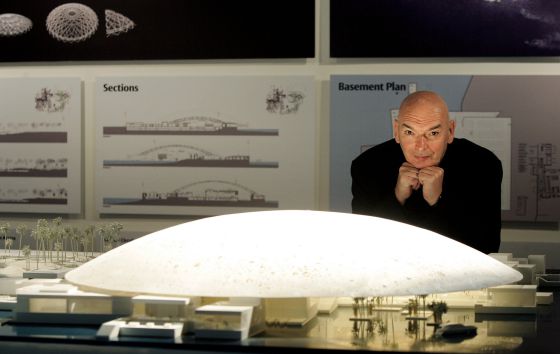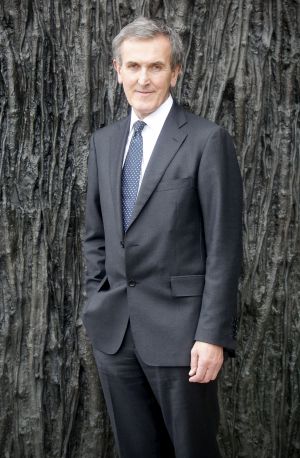Cleverly installed over astroturf rugs inside Paul Kasmin Gallery, Mattia Bonetti’s new collection of high-design furniture is meant to transition seamlessly from living room to garden. The Swiss-born, Paris-based designer is known for his irreverent, eye-grabbing, and — often — dazzlingly shiny functional objects. Titled “Indoor/Outdoor,” the exhibition showcases Bonetti’s ecumenical rage of styles, from a spartan contemporary take on the klismos (an ancient Greek chair) to a neo-baroque cabinet tricked out with gold-plated bronze baubles. Highlights include a table made from shimmering rock crystal, a wicker dining set cast in bronze, a table with legs that imitate the undulations of a pearl necklace, and a monolithic travertine bench fit for a giant.
The Swiss-born designer talked to ARTINFO about how he conceived the objects in the new show.
What inspired your foray into outdoor furniture?
The idea was to bring the outdoor into the indoor, and to bring the indoor into the outdoors: to blur the lines. I am not the first, nor will I be the last, to bring a garden chair into the home, or a settee outside. But I do like the idea of blending the two. I’ve been working on pieces that are originally made of wicker. They are cast bronze from a wicker model. Wicker by definition is associated with the outdoors, although in the 19th century it was very much fashionable to have wicker indoors as well.
Do you mix indoor and outdoor furniture in your home?
I do not because I live in an apartment. The only thing I can do is open the window and feel the air.
Was it your idea to install the AstroTurf in the gallery?
I wanted it that way because I think it explains the concept, because we have grass but we are indoors. Also, outdoor doesn’t mean necessarily in the middle of the forest. It can be a covered terrace or a balcony, or some sort of building in a garden, there are all of these indoor/outdoor spaces.
You call your works functional sculptures. Where do you see it falling between art and design?
To be frank and honest, all my works are to be used as furniture. On top of that, they may have an aspect that’s more sculptural than what you find on the market. Because once the function is answered, you can do whatever you want. You don’t need to be Bauhaus or minimalistic, although you can.
Do you have a favorite piece in the show?
I do like the [travertine] couch a lot because of its mass. It was carved from a block. It was very difficult to produce. Also, the little table made with rock crystal: I like it very much.
You like to play with organic and geometric forms. The rectilinear and modernist “Metals Coffee Table” couldn’t be further from almost-rococo curvature of “Rocky Side Table.” What interests you about refusing to adhere to a consistent style?
I’m always divided between the two. Because I like both. I can’t make a decision and I don’t want to make a decision. I’m always very mixed up. Business-wise, it’s better when people systematically repeat one thing. It becomes a brand. It’s immediately recognizable. Whereas, I change very often. From one show to the next, things are very different.
The [Liquid Gold] cabinet combines the two [aesthetics], I would say, because it’s quite straight in line, but you have all these ripplings that are more informal. They could be called Baroque, with their guiding and the richness.
There are certain motifs that you do bring back, such as your table with the pearl legs or the dice motif.
Yes, I’ve done that before and then we decided to make it in a smaller size. I’ve done two dice pieces for a client in Hong Kong many years ago, but they were made of wood. We always liked it, so we said, why don’t we make one in metal that can go indoors or outdoors.
What appeals to you about the dice motif?
I think it’s very surrealistic. My work sometimes is also on the verge of surrealism.
What designers influence you?
I quite like the design of the second part of the 19th century, the Aesthetic Movement. It’s very decadent but at the same time also on the verge of something very modernistic — and you can feel that. And I think it's very interesting when you have those moments of passage. Because you had people like Christopher Dresser, for example, who was so advanced. I like [Edward William] Godwin and that kind of thing.
Your work has been deemed “neo-baroque,” “neo-barbarian,” and “postmodern.” How would you classify yourself?
I don’t. I refuse to classify, but everything is ok.
What are you working on next?
I’m planning to have a show with my English gallery [London’s David Gill Gallery] in one year’s time. I’ve also been asked to do a couple of objects for Christian Dior’s shops, objects that will not be sold. They will be there to evoke. The first one is in Paris on the Avenue Montagne. They have an apartment that’s been installed as if it were Christian Dior’s original place. I think that some of the items did belong to him originally. They asked me to do a mirror, so I did a very surrealist mirror inspired by Dior imagery. I used the Dior ribbon in a new way and I made a hand that comes from the back of the mirror and goes through it — very surrealist. It’s a ladies hand, but it has spots like a leopard.
See a slideshow of Mattia Bonetti's "Indoor/Outdoor" at Paul Kasmin Gallery here











